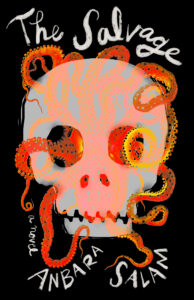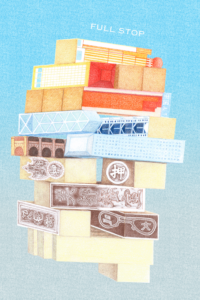
[Tin House; 2025]
I am not much of a diver, snorkeler, surfer or swimmer. Water has always appeared, to me, as an unrelenting force with incomprehensible rules. This underworld contrasts against our world on top: it is quiet, dark, pressurized and full of unknowns that only certain people get to see or understand.
In Anbara Salam’s The Salvage, that person is marine archaeologist Marta Khoury. On an assignment in the fictional island of Cairnroch, off the east coast of Scotland, Marta has been tapped to dive down and dredge up any salvageable items from the HMS Deliverance shipwreck to draw more tourists to the small town. The captain of the HMS Deliverance, Captain James Purdie a.k.a. Auld James, is a communal beacon for the people of Cairnroch. Perfect in his posthumous fame, he embodies the history and identity of the small town and, in turn, is revered as an influential figure. While Marta is diving deep into the sea, “traveling into a moment that has been paused in time,” she finds the remains of Captain Purdie along with other museum-worth materials: a tin spectacle case, a golden ring, a copper coin. As she pulls herself away from the saloon of the ship, “a flicker of movement” catches her eye. She sees a figure crouching underneath a window inside the ship. Marta becomes convinced that her past actions are now stalking her, taunting her. Karmic repercussions are underway.
Marta is still technically married to her boss, Alex, when she arrives in Cairnroch, but we come to understand that the relationship has been rocky for years: miscommunication, disagreement, and adultery. Through a first-person perspective, these layers start to accumulate. Because we are so close to Marta and her guilt, we see her holding onto anchors that are causing her to sink. In The Salvage, Salam is shedding light on a universal human experience through a new lens, a new environment, with different stakes: after all, we all hold onto guilt in some way in our lives. We blame ourselves for the actions of others, sometimes because it is the path of least resistance. We believe that we deserve a kind of tangible, real punishment and we dig ourselves into the ground, waiting to receive it. Salam writes, when Marta feels the presence of her past inching closer to her: “Maybe that’s why he’s following me. Because I’m just like him. A secret monster, heading for a miserable end.”
A sense of bifurcation drives the novel. There is the ocean and the land, the living and the dead, the good and the bad, the “elect” and the damned. The “elect” and the damned are opposing forces serving as part of the religious belief system that makes up the small town and the people in it. Through Marta’s first-person perspective, we arrive at Cairnroch as outsiders, as well, and the novel replicates the perspective of a landscape painter attempting to understand the geography of the land and its inhabitants:
It was three hours before Cairnroch came into sight. A sudden gleam of sun on the red-and-white ice cream swirl of the Captain James Purdie Lighthouse, a hint of rainbow in the sea spray. A row of pastel-coloured houses stretching along the waterfront puffed coal smoke from narrow chimneys. As we entered the deep bowl of Port Mary Harbour, the ferry slid through oily slicks in the sheltered water, drawing up into a waiting crowd.
Though there is light and sun on the horizon, “oily slicks” linger on the surface of the water, shielding what may be below, obfuscating the view. Salam’s prose is delicate, especially when she describes landscape: a frozen river becomes a “light blue ribbon that cuts through the hillsides,” and cold weather transforms into woolen air, “heavy with the catmint smell of deep winter.” It reminds me of Luc Besson’s film, The Big Blue, with its wide shots of the sea against the rocky backdrop of Greece. The environment in The Salvage works in tandem with the characters’ predicaments. At first, Marta is able to dive into the open water expertly and cautiously. After some items from the shipwreck are stolen, forcing Marta to do some detective work around town, the winter begins its slow and deliberate takeover, making it more difficult for Marta to revisit the shipwreck. As the snow falls and the ice hardens, trapping Marta in Cairnroch for longer than she’d hoped for, the true conflicts begin to arise.
Set in October of 1962 through February 1963, the novel occupies a political environment of high anxiety. The Cuban Missile Crisis is underway and the threat of nuclear disaster is non-discriminatory. Salam expertly creates these concentric circles of macrocosm and microcosm, utilizing the global anxieties to bring forth the interpersonal anxieties in Cairnroch. In a pivotal moment, when a perceived nuclear threat forces the people of Cairnroch to bunker down in the church, Marta is denied entry, as she is not part of the “elect.” This denial comes after a minister’s sermon that laid out the practiced beliefs of those selected for heaven, and those not. “My mind goes back to the minister’s sermon,” thinks Marta. “The chosen and the reprobates. And all of those people sitting on their hard benches in the hard church, believing themselves to be saved and watching their neighbours for evidence of damnation.”
Salam’s prose shines in these sections of religious worldbuilding. Because Marta’s past haunts her, she latches onto the townspeople’s argument of the elect versus the unsaved; she is seeking punishment or absolution. When we do bad things, we want to be told that we are still inherently good people. Salam uses Marta to help these questions bubble up to the surface: How do you determine who is a good or bad person? Who decides who is saved?
A narrative counter to this town-wide ethos is Elsie, a local woman who works at Marta’s hotel. Through Elsie, we feel established in Cairnroch’s culture and its idiosyncrasies—she behaves as a guide for Marta before their relationship takes a romantic turn. The relationship also serves as a driver of dramatic tension and as a mechanism for Marta to mature. Marta initially withholds secrets from Elsie, and over time, as trust is established and as Marta releases some of her internalized guilt, the relationship deepens. Though this is a comforting arc, flawed and fallible to changed and renewed protagonist, Salam imbues this transformation with such curated attention that it feels fresh. On the final dive, we sense the end of Marta’s evolution in Cairnroch:
The cold judders my heart and I curl with my knees to my chest in the water, gathering my heartbeat back to myself. All these months of being frozen have finally provided their use; I am more resistant to the cold now than I have ever been. The water is close to eight degrees, even warmer than the air.
By staying with that arc of flawed to healed, Salam not only conveys that Marta’s body has acclimated to a new environment, but also suggests that her mental fortitude has changed in the process. When it comes to self-forgiveness, it is less about forgetting your past actions and more about deciding how to live with them. Deciding how much breadth they should take up. We leave Marta knowing that she’s moved past the point of self-punishment, but we also know that it’s a constant practice, one we hope we get better at day after day.
Alia Spartz is half-Mexican and half-Italian and grew up in Atlanta, GA. She received a masters in Latin American Literature and Culture from UC Davis, and is currently an MFA candidate in Fiction at the University of San Francisco. She lives in San Francisco.
This post may contain affiliate links.






